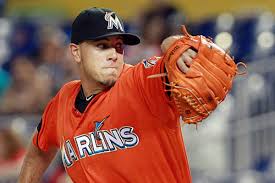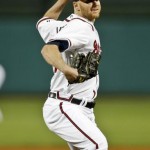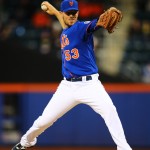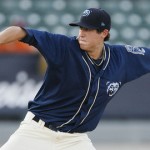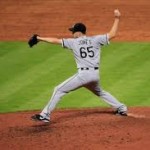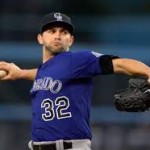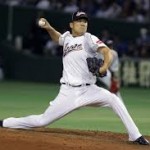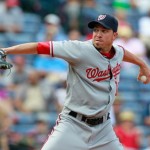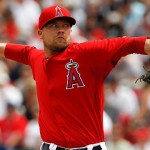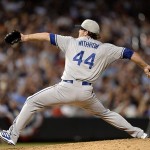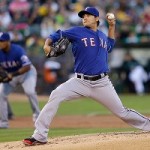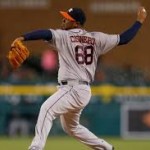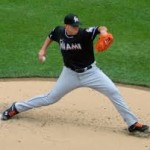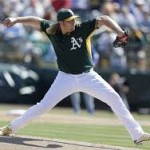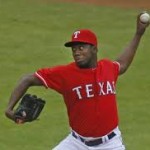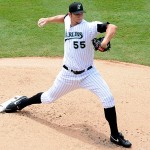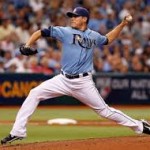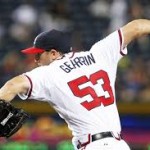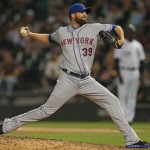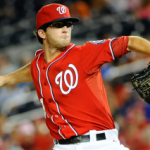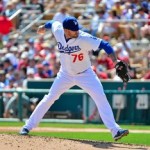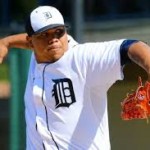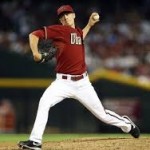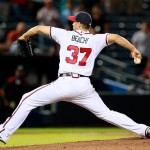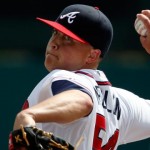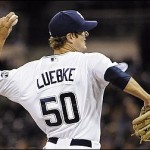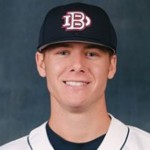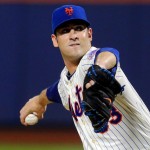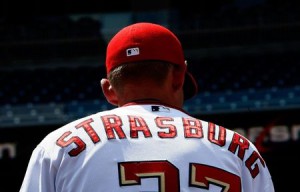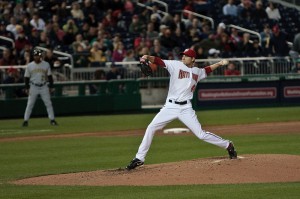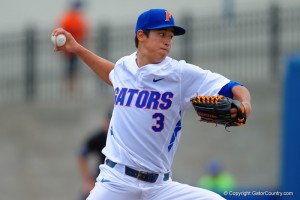
Dane Dunning was a 1st round pick and was arguably the best producer in 2016 of his draft class. Photo via gatorcountry.com
Editor note: from this post forward i’m going to start tweeting out via the new Nationals Arm Race twitter account. @natsarmrace is the account. I’m going to try to do a better job promoting the blog and its posts since, hey, why not. Feel free to follow me there and retweet if you’re into that to get more people involved in the discussion.
In years past, I’ve adapted a topic stolen from minorleagueball.com’s John Sickels and reviewed all our draft classes statistically. Last years set of posts (2015 draft class, 2014 draft class, 2013 draft class, 2012 draft class and 2011 draft class) turned into a great way to see how everyone was doing, and helped me write rotation reviews later on. So let’s do it again! Using last year’s posts to help make this year’s writing go better, we’re going to do another series of posts on each draft class.
First up; 2016’s class. Here’s a fast review of the 2016 draft class, looking at their 2016 numbers and making some snap judgments.
Web links to use while reading:
- Stats are pulled from milb.com and/or fangraphs.com; put the player name into the search bar to get his seasonal stats
- The MLB.com Draft Tracker (which I believe is the best draft tracker out there) is the best place to get draft class information.
- The Big Board and the Draft Tracker are the goto resources for prospects for any Nats fan.
- More obscure stats on players are sometimes found at places like thebaseballcube.com, perfectgame.org, their college websites, twitter accounts for the players, and good old fashioned deep-dive googling.
At the end of each player write-up i’ll put in a color coded trending line for the player: Green for Trending Up, Blue for Trending steady, Red for Trending Down. This is just my knee-jerk opinion of the prospect status of the player system-wide. And yes I realize this is their first pro ball season, short-sample sizes, scouting the stat line, etc etc. So apologies in advance if you think i’m being too harsh passing judgement on a 15 inning sample size. Of course I am; what else are we going to argue about this off-season? :-). I solicit any and all feedback from those who actually saw the games, who think differently or who have inside information that i’ve missed here (like last year when we found out that Perkins was converting to switch hitting).
Without further ado:
Round 1: Carter Kieboom, SS, Walton HS (Georgia). Slashed .244/.323/.452 in 135 at-bats in the GCL, signing four days after being drafted and thus getting as full of a season in as could be expected. 43/12 K/BB in 135 ABs, 4 homers, 1 SB in 36 games. He played SS exclusively and made 9 errors in 31 games in the field. When he did hit the ball, he hit for a decent amount of power (.452 slugging). At age 18 he’s still a year and a half younger than the average age of the GCL, so this is a positive start. Still, I think he’d be hard pressed to make a full season squad in 2017, so I’d expect him to repeat GCL in 2017. Trending Steady.
Round 1: Dane Dunning, RHP (starter) Coll Jr from UFlorida. 3-2, 2.14 ERA in Short-A (ignoring 2 innings at the GCL) with 29/7 K/BB in 33 2/3IP (7 app, 7 starts, 1 CG). 0.98 whip, 2.57 FIP, .263 babip. He gave up 26 hits and one homer in those 33 innings, which is more or less in-line with the numbers he posted for the University of Florida his junior year in a swing-man role. I like Dunning and I like his approach; he comes right at you, doesn’t shy away from contact, and makes you hit his pitch. He had a sub 1.00 whip, which is great from a starter at any level. He doesn’t have eye-popping stuff, but he seems to consistently getting guys out. You can’t ask for a better apprenticeship than Florida and SEC baseball, so he seems like a good candidate to jump from Low-A to High-A next season. Trending Up.
Round 2: Sheldon Neuse, 3B Coll Jr. from Oklahoma. Slashed .230/.305/.341 in 36 games in Short-A. 26/13 K/BB in 126 ABs, 1HR, 2SB. Played mostly 3B (filled in 6 games at Short) and made 5 errors in 222 innings while playing third. Neuse struggled a bit in his first pro season, not hitting anywhere close to the .369/.465/.646 slash line he put up in his stellar junior year. And he ended up missing nearly half the season in two separate stints of inactivity. I’d definitely say this is a disappointing debut season, but luckily for Neuse he’s a big bonus kid so he’ll get plenty of time to work things out. I fully expect to see him starting at 3B for Hagerstown next year; he’s not going to be kept in XST to start the year. Though I will say it was interesting to see that a 17th rounder from this same draft “jumped” Neuse and finished the year starting at 3B for Low-A (more on that later). Trending Steady, barely.
Round 3: Jesus Luzardo, LHP (starter) from S. Douglas HS (FL). No Stats in 2016; he had Tommy John surgery on 3/22/16 and spent the season on the GCL D/L. We’ll see him in the GCL next year. Trending Steady.
Round 4: Nick Banks, OF (Corner) Coll Jr. from Texas A&M: Slashed .277/.310/.320 in 60 games in Short-A. 37/11 K/BB in 231 ABs, Zero homers, 7 SBs. Not a ton of power from Banks in his first pro season; he slugged just 10 points higher than his OBP. Banks is a tough one; I loved this pick back in June, so I’m not going to kill him yet, but clearly we need to see a bit more from a guy who is already relegated to a corner OF position. I suppose its possible he’s still affected by the back surgery he had in late 2015 (that was the excuse for his college junior stats falling off), but that’s nearly a year in the rear-view mirror by now. He’s presumably pushing Rhett Wiseman up a level since they’re both upper round-drafted corner-only outfielders. Trending Down.
Round 5: Daniel Johnson, OF (CF) Coll Jr. from New Mexico State. Slashed .265/.312/.347 in 62 games in Short A. 42/7 K/BB in 245 ABs, 1HR, 13SBs split between playing CF and RF. Wow; just 7 walks in 245 ABs; that’s not good. As with Neuse and Banks, the slash line isn’t that impressive though Johnson managed better power numbers by showing a bit of gap power (9 doubles, 4 triples). He should move up with his draft class to low-A next year, but (again, as with Neuse and Banks) we need to see some improvement and some patience at the plate. Trending Steady.
Round 6: Tres Barrera, C Coll Jr. from Texas. Slashed .244/.337/.366 in 48 starts behind the dish for Short-A. 22/15 K/BB in 164 ABs, 3HR, 0SB. A solid season for the catcher, who led Auburn’s qualifying players in OPS on the year. An interesting decision may eventually await the team; is Barrera good enough for the team to decide to cut bait on Jakson Reetz? Reetz improved his numbers greatly this year (which we’ll discuss in the 2015 draft class review post), and there’s a straightforward promotion path for Reetz, Raudy Read and for Barrera this year … but it is going to get crowded at the top and soon. Trending Up.
Round 7: Jacob “Jake” Noll, 2B Coll Sr. from FGCU. Hit .318 in 18 games in Auburn and earned a promotion on 8/1/16 to Hagerstown. Slashed .275/.332/.401 across 3 levels in 2016. 26/15 K/BB, 5homers, 3SB in 207 ABs. A good season for a senior sign, who should start at 2B again for Hagerstown in 2017 and look to continue his excellent start to his career. Trending Up.
Round 8: A.J. Bogucki, RHP (starter) Coll Jr. from UNC. 0-6, 8.20 ERA in 10 games (6 starts) for Auburn. 17/14 K/BB in 26 1/3 IP. 1.97whip, 4.53 FIP, .378 BABIP. So clearly a 4-point delta between his ERA and FIP highlights a bit of unluckiness in Bogucki’s numbers this year. Still, nearly 2 baserunners an inning is an awful place to reside. He had two especially bad outings that helped inflate his numbers, but overall its hard to see Bogucki having a guaranteed full-season spot next year. I presume he’s in XST and then re-trying short-A in 2017. Trending Down.
Round 9: Joey Harris, C Coll Sr. From Gonzaga. Slashed .301/.414/.329 in 26 games catching roughly every third day in the GCL. 15/9 K/BB, zero HR, 1SB in 73ABs. He had a nice average .. but non-existent power even despite being a 22yr old in a rookie league. Harris was a cut-rate bonus senior sign and the odds of him making it past next season’s draft seem slim. Trending Down.
Round 10: Paul Panaccione, SS/Util Coll Sr. from Grand Canyon U. Slashed just .205/.254/.250 in 50 games serving as a utility backup for Auburn. 20/9 K/BB, zero homers, 1 SB in 176ABs. There doesn’t seem to be any cinderella stories with the senior signs this year; like Harris above, Panaccione seems like he’s a quick release once the 2017 class starts signing. Trending Down.
Round 11: Armond Upshaw, OF (CF) J2 from Pensacola State CC. Slashed .325/.391/.400 in 13 games (40 ABs) for the GCL. He missed a couple of weeks in July then did not play after August 1st. He had a promising start for sure and, assuming there’s not a serious, long-term injury he should make sense to perhaps compete for a spot at Low-A Hagerstown in 2017. It’s too small sample size to really pass too much judgement, so we’ll go with Trending Steady.
Round 12: Hayden Howard, LHP (reliever) Coll Jr. from Texas Tech. 0-2 with a 5.06 ERA in 11 games for Short-A. 12/9 K/BB in 21 1/3 innings, 1.73 whip, 4.03FIP, .365 babip. Not the best start from Howard, who was one of the last drafted players to sign and start his career. He mostly pitched 2-3 inning relief stints but didn’t show much in the way of swing-and-miss stuff. His BABIP shows he was a bit unlucky, and at the risk of over-reacting to 21 innings, I’d say he’s already on a short leash. He’ll be competing for a bullpen spot in Hagerstown next year. Trending Down.
Round 13: Conner Simonetti, 1B Coll Jr. from Kent State. Slashed .280/.333/.446 for the GCL Nats. 54/13 K/BB ratio, 6 homers, 0 ABs playing 1B for the rookie league squad. A college junior should have at least made the Short-A team; i’m guessing Simonetti was pushed to the GCL thanks to a numbers game. 54 strikeouts in 42 games played against guys who were 1-2 years younger is the biggest concern i’d have here; I would like to have seen more contact. Just based on where he played in 2017, i’m going to say Trending Down.
Round 14: Kyle Simonds, RHP (reliever) Coll Sr. from Texas A&M: 0-3 with a 2.51 ERA in 13 games (3 starts) for Auburn. 27/8 K/BB in 32 1/3 innings. 1.08 whip, 3.43 fip, .272 BABIP. A nice little season for the senior sign Simonds, who got a few “starts” (which I put in quotes because clearly they were doing tandem starts) but mostly was a 2-3inning middle reliever. Good K/BB ratio, good overall numbers, kept baserunners to a minimum. I think he’s a shoe-in for middle relief in Hagerstown next year. Trending Up.
Round 15: Ryan Williamson, LHP (starter) Coll Jr. from NC State: No Stats in 2016; he had Tommy John surgery on 6/22/16 with Dr. Andrews and spent the season on the GCL D/L. We’ll see him in XST next year to start and then likely with Auburn in 2017. If he recovers, this could be another nice pick for the Nats; he had promising numbers as a weekend starter for NC State this year (7-2, 2.69 ERA in 13 starts) Trending Steady.
Round 16: Phil Morse, RHP (reliever) Coll Sr. from Shenandoah U (by way of McLean HS): 1-0, 7.79 ERA in 19 games as a late-innings reliever for Auburn. 23/13 K/BB ratio in 21 innings, 2.24 whip, 3.37 fip, .508 babip. So, at first glance his ERA and WHIP look awful. But look at his BABIP: above .500! That’s 200 points or more above where it should be, and his FIP indicates it. So, hopefully the Nats officials also see this vast discrepancy and give him another shot. It looks like he was used as an 8th/9th inning guy because of stuff, so in short outings one string of hits can really inflate your stats. I think he gets another look in the Hagerstown bullpen next year. Trending Steady.
Round 17: Tyler Beckwith, MIF Coll Sr. from URichmond; slashed .253/.330/.331 across 45 games across two levels. 44/16 K/BB ratio, 1HR, 5SB in 166 ABs. Beckwith spent most of the season in the GCL despite being a college senior sign, then interestingly was promoted to Hagerstown to finish out the season. He split time evenly between 2B, SS (his drafted position) and 3B. In the GCL, his OBP was higher than his slugging, indicating very little power potential here. He will compete for a full season job but already seems behind higher-drafted players from 2016 (Neuse, Noll) plus some aging IFAs from the D.R., plus some hangers on from prior drafts. He could be a release candidate soon after the 2017 class is drafted. Trending Down.
Round 18: Ben Braymer, LHP (Starter) Coll Jr. from Auburn: 0-2 with a 4.12 ERA in 8 games (2 starts). 24/13 K/BB in 19 2/3rds innings, 1.32whip, 3.02 fip, .289 babip. Braymer was used as a notional “starter” despite not getting the official starts; he was kept on a starter’s regime for the GCL but was shut down in early August (unsure if injury or just innings limits). He was a Junior out of Auburn, where he was a highly regarded Juco transfer and was used as a swingman. I’d like to see how he’d fare against like-aged players; more than a K/inning but against rookie league guys. I’m hoping he competes for at least the Hagerstown rotation next year. Trending Steady.
Round 19: Jarrett Gonzales, C from Madison HS in San Antonio; did not sign, apparently honored his college commitment. At the time of the draft, I had him committed to Grayson Junior College in Denison, North Texas. However, perfectgame.org now has him committed to Dallas Baptist University. He is cousins w/ Garrett (our 32nd round pick, see below) and nephew of Nats scout Jimmy Gonzalez. Initially I thought this might have been a “favor pick,” but you don’t generally blow 19th round picks (35th round? yes). The fact that he’s going to a powerhouse baseball program lends a bit more credence to his drafting in this spot.
Round 20: Jake Barnett, LHP (starter) Coll Jr from Lewis-Clark State (Idaho). 0-0, 1.80 ERA in 2 games and just 5IP for the GCL. Barnett signed on 6/20, reported to Florida on 6/24, pitched on 6/25 and then again on 7/1 … and then didn’t pitch again. There’s no D/L assignment. I guess we have to say he’s Trending Steady until we find out his fate next spring.
Round 21: Jacob Howell RHP (reliever) Coll Jr. from Delta State (Miss.). Posted a 2-1 record with a 3.49 ERA across 28.1 innings and three levels. Looking just at his time in Hagerstown; 4.57 ERA, 15/7 K/BB in 21 2/3 innings. 1.25 WHIP, 3.59 FIP, .279 Babip. Howell quickly moved from the GCL through Auburn to live in Hagerstown for most of the year, becoming the first 2016 draftee to matriculate to full-season ball. Not bad for a 21st rounder from a small school. His FIP indicates that his numbers are better, and his season was cut short a month with injury. I’d suspect he’ll start again in Hagerstown in 2017 (unless his injury was serious) and move on up from there. Good first pro season. Trending Up.
Round 22: Sterling Sharp, RHP (starter) Coll Jr. Drury (Mo.). Posted a 3-0 record with a 3.24 ERA in 11 games (7 “starts”) in the GCL before getting an end-of-season promotion to Auburn. 35/6 K/BB in 41 2/3 innings in GCL. 1.27whip, 2.85 fip, .354 babip. Nice looking numbers, much better than his college numbers this year, but done against younger competition even given the fact that he went to a smaller school. His one Auburn start was solid and efficient; 5 innings, 2 runs on 69 pitches. I like what I see, but will repeat the typical age-related caveat for all college kids in the GCL. We’ll know more when he hits a Short-A or Full-season league. Trending Up.
Round 23: Michael Rishwain, RHP (reliever) Col Sr. Westmont (Calif.); was 1-0 with a 3.63 ERA in 13 relief appearances in the GCL. 14/5 K/BB in 17 1/3 innings. 1.90 whip, 2.58fip, .400 babip. His usage was odd; he only pitched about every 5th day despite not being a “starter” in the GCL, and had several “gaps” of more than a week between appearances. He also gave up a gazillion hits; 28 in his 17 innings to go along with a few walks, hence the inflated WHIP. If they were holding him back to manage his innings that is one thing; if he was only getting brief looks because every time he got on the mound 2 guys got on base, then he may not be long for the season. I see him as a long-shot to make a full-season bullpen and he may be a mid-season 2017 release. Trending Down.
Round 24: Joseph Baltrip RHP (reliever) J2 from Wharton County (Texas) JC; went 2-1 with a 1.38 ERA in 16 relief appearances in the GCL. 17/23 K/BB in 26IP. 1.46whip, 5.40 fip, .194 BABIP. Well, I loved the ERA until I saw the K/BB ratio; he walked 23 guys in 26 innings. Look at the delta between his ERA and FIP. Despite being a J2 guy, he was 21 at the point of drafting so he’s the same age as a typical College Junior. Clearly he’s got some control issues to work on. As with previous college RHP relievers who were in the GCL all year, results need to be shown in like-age leagues and soon. Trending Down.
Round 25: Branden Boggetto, SS Col Sr. Southeast Missouri State. Slashed .280/.328/.411 in 32 games in the GCL. 13/6 K/BB ratio, 3 homers, 2 SBs in 107 ABs. Drafted as a SS, he played mostly 2B in the GCL this season. Solid enough numbers for Boggetto, but (and I feel like a broken record) he’s 22. I’m guessing he has a shot at a utility position for a team next season, but the roster’s crowded. Trending Down.
Round 26: Jack Sundberg OF (corner) Col Sr. Connecticut. Slashed .256/.346/.340 while earning two promotions and ending the season in Hagerstown. 33/22 K/BB ratio, 1 homer, 12SB in his three stops. You cannot complain about a 26th rounder who earned two promotions, even if the jump from Short-A to Low-A seemed odd based on his stat line in Auburn. He played mostly LF, where you hope for a bit more power. He did feature at CF a bit, so perhaps it was a positional thing. A great first pro season. Trending Up.
Round 27: Jeremy McDonald, LHP (starter/reliever) Col Sr. California Baptist. Went 2-1 with a 3.42 ERA in 11 appearances in the GCL. 27/5 K/BB ratio, 1.22 whip, 1.85 fip, .338 BABIP. Yes he’s old for the level (he turned 23 just after the season ended), but clearly he’s got some command. Nearly a 6-1 K-BB ratio is great. I’m slightly surprised he didn’t get bumped up to one of the A-ball levels, but (like a few before him) he seemed to be on a starters schedule all season. He generally went every 5th or 6th day even though he was only throwing 2-3 innings at a time. I can see him competing for rotations in Low- or Short-A next year. Trending Up.
Round 28: Jonathan “Jonny” Reid, LHP (starter/reliever) Col Jr. Azusa Pacific (Calif.). Went 3-1 with a 2.50 ERA across two levels, ending the year in Auburn. 24/7 K/BB, 0.94 whip, 4.41 fip (in Auburn), .281 babip (in Auburn). Reid quickly proved to be unhittable in the GCL (8 hits in 15 2/3 innings) and got jumped to Auburn after a month. There he pitched on a starter’s rotation, going every 5th day or so for 2-3 inning stints and finished with a 3.10 ERA in 7 outings. He should compete nicely for a full-season rotation job or at least have a look at being a longer-man out of the pen. Trending Up.
Round 29: Sam Held RHP (starter/reliever) Col Sr. Nevada. Went 1-2 with a 1.86 ERA across three levels, ending the year in Hagerstown. 22/8 K/BB ratio, 1.14whip combined for the year. Like a couple guys before him. Held quickly showed he was too good for the GCL and got jumped to Auburn after three weeks. There, he held his own for a month of tandem starter appearances before finishing the last few weeks in Hagerstown. He more than held his own once he got to full-season ball and should at least start there in 2017. Trending Up.
Round 30: Tristan Clarke, OF J2 Eastern Oklahoma State JC. Did not sign, honored his commitment out of JuCo to attend the University of New Orleans.
Round 31: C.J. Picerni, C Col Sr. New York. Had just 8 ABs for the GCL, and it took 5 weeks for him to even get an appearance. No idea what to think here; was he hurt? Given his draft round and his lack of playing time, you can only assume he’s a short-timer until we get more information. Trending Down.
Round 32: Garrett Gonzales, 3B HS San Antonio HS in Texas. Did not sign, honored his college commitment to Incarnate Word. As noted above, he is cousins w/ Jarrett (our 19th round pick). This seems like a “favor pick” for sure; he’s reportedly the son of a Nats area scout.
Round 33: Ryan Wetzel SS Heritage Christian Academy in Overland Park, Kansas. Did not sign, honored his college commitment to Pitt State. The son of a special assistant to the GM for the Nationals, so definitely another “favor pick.”
Round 34: Morgan Cooper, RHP (starter) Col Jr. Texas. Did not sign, decided to return for his senior year (technically his redshirt junior year) at Texas. He had Tommy John surgery, which caused him to miss the whole 2015 season. In 2016 he was a mid-week starter for Texas, so likely he wanted to return to Texas to improve his draft standing for 2017. Makes sense. If he can produce as a weekend starter in the Big12 two years removed from surgery he’ll be looking at a decent bonus next year.
Round 35: Tristan Bayless LHP (starter) Hutto (Texas) HS. Did not sign, honoring his commitment to McLennan Community College. Bayless had a nice season on the mound for his prep team but was not a heavily scouted or recruited player apparently. PerfectGame had very little on him and only some deep googling returned his Juco commitment.
Round 36: Jordan McFarland OF Waterloo (Ill.) HS. Did not sign, honoring his commitment to Arkansas. McFarland was a big-time player; a 2nd-team PerfectGame All American and this may have been the Nats planting a seed for a pick three years from now.
Round 37; Cory Voss C J2 McLennan (Texas) CC. Did not sign, honoring his planned transfer to U of Arizona for 2017. Voss played his freshman year at New Mexico, went JuCo sophomore year and then was playing in the Cape this past summer. He joins a very good recruiting class for Arizona and will be back in next year’s draft.
Round 38: Noah Murdock RHP (starter) Colonial Heights (Va.) HS. Did not sign, will honor his commitment to UVA. Murdock was one of the players I was tracking all spring and once he passed out of the top 10 rounds it was clear he’d go to school. He will help augment a UVA rotation that lost its ace and may be struggling for starters in 2017.
Round 39: Matt Mervis 1B Georgetown Prep HS, North Bethesda, Md. Did not sign, will honor his commitment to Duke. Another local kid drafted; Mervis was no favor pick. He was highly ranked (the #1 prep player in Maryland according to one source Prep Baseball) but clearly going to Duke is a better alternative than a minimum bonus at this spot.
Round 40: Sean Cook RHP (starter) Whitman HS, Bethesda, Md. Did not sign, will attend Maryland and “attempt to walk-on.” Definitely seems like a “favor” draft pick to someone, in that Cook was not on anyone’s radar, does not have a perfectgame profile and is not even a guarantee to make Maryland’s team. Perhaps further evidence that the MLB draft is still 8-10 rounds too long.
Trending Summary:
- Trending Up (10): Dunning, Barrera, Noll, Simonds, Howell, Sharp, Sundberg, McDonald, Reid, Held
- Trending steady (7): Kieboom, Neuse, Johnson, Upshaw, Morse, Braymer, Barnett
- Trending steady b/c they’re injured all year (2): Luzardo, Williamson
- Trending Down (11): Banks, Bogucki, Harris, Panaccione, Howard, Simonetti, Beckwith, Rishwain, Baltrip, Boggetto, Picerni
- Did Not Sign (11): Gonzales, Clarke, Gonzales, Wetzel, Cooper, Bayless, McFarland, Voss, Murdock, Mervis, Cook
Executive Summary
So far, the key names out of this draft have done decently. I’m worried about Banks and (to a lesser extent) Neuse. Its great to see 20th+ round guys like Reid and (especially) Held produce and earn promotions; that’s a feather in the cap of the scouting department for those finds. Its just a half a season of course, but plenty of guys are on course or impressing out of this class.

